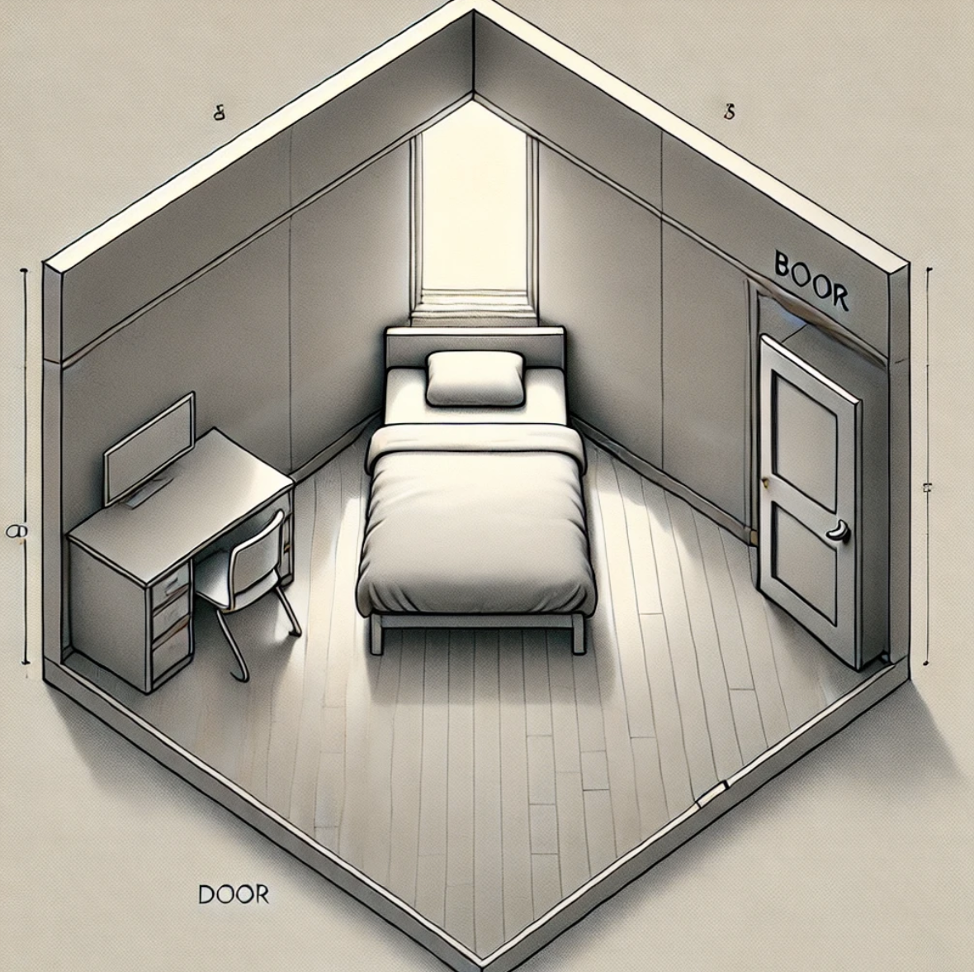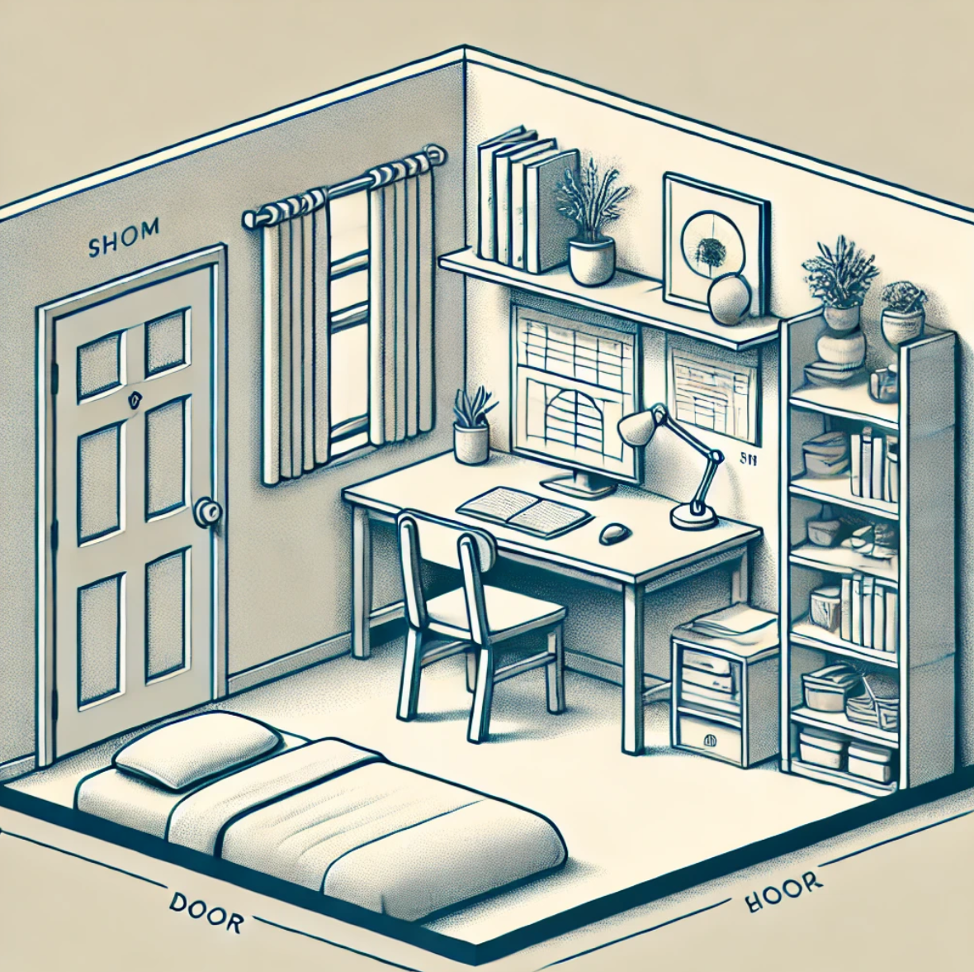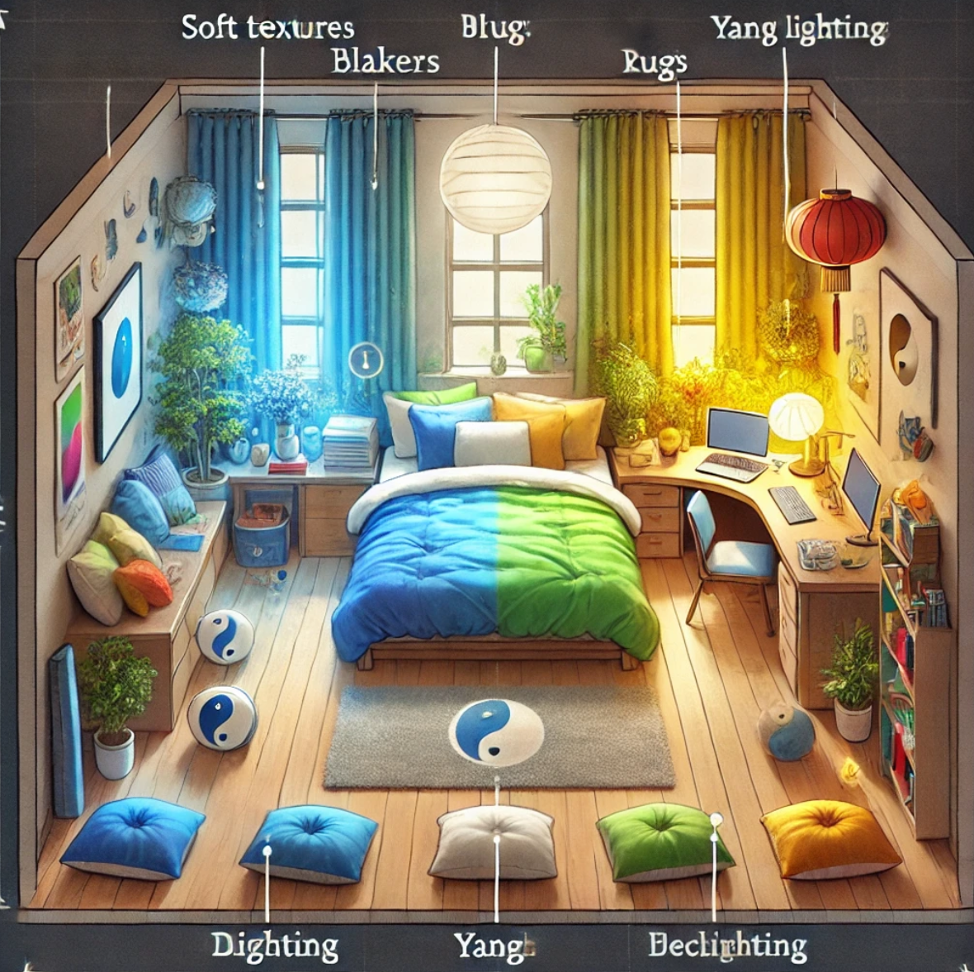A dorm room is often a small, multi-functional space where you sleep, study, and relax. Applying Feng Shui principles to your dorm room can help create a more balanced, harmonious, and productive environment. Feng Shui is the ancient Chinese practice of organizing spaces to encourage the flow of positive energy, or “Chi.” This can lead to improved focus, better sleep, and a more comfortable living area—all crucial elements for a successful academic and personal life.
This article provides practical tips to apply Feng Shui to your dorm room, even if the space is small or shared with a roommate.
1. Bed Placement for Restful Sleep

In Feng Shui, the bed’s position is the most important factor in ensuring restful sleep and good energy flow. Ideally, the bed should be in the “commanding position,” meaning that when you lie down, you can see the door without being directly in line with it. This placement helps you feel more secure and in control while you sleep.
If possible, avoid placing the bed directly under a window, as this can lead to disrupted sleep due to fluctuating energy from outside. Instead, place the head of the bed against a solid wall for support. If your bed must be near the door or window due to space limitations, using curtains or a headboard can help create a sense of stability.
Key Tips:
- Avoid placing the bed directly under a window or in line with the door.
- Position the bed so you can see the door without being directly in front of it.
- Use a headboard or a solid wall behind the bed to provide support and security.
2. Declutter for a Clear Mind

Clutter is one of the biggest enemies of good Feng Shui. A messy, disorganized dorm room can block the flow of Chi and lead to feelings of overwhelm, stress, and distraction. Keeping your space tidy will promote mental clarity and help you stay focused on your studies.
Maximize storage space with under-bed bins, closet organizers, and shelves to avoid clutter on the floor or desk. Use drawer dividers and baskets to keep smaller items neatly contained. Make it a habit to regularly clear away anything you don’t use or need.
Key Tips:
- Keep your dorm room organized and clutter-free to allow Chi to flow freely.
- Use storage solutions like bins, shelves, and organizers to maintain order.
- Regularly declutter and remove unnecessary items to keep the space fresh.
3. Study Space and Desk Placement

In a dorm room, your desk is a place where you spend a significant amount of time studying and working on assignments. According to Feng Shui, the desk should be placed in the command position, similar to the bed. Ideally, you should be able to see the door from your desk without having your back to it. This promotes focus and reduces feelings of vulnerability while studying.
If space limitations require your desk to face a wall, use mirrors to reflect the room behind you, symbolically expanding the space. Keep your desk organized and free of clutter, as a messy workspace can lead to distractions and reduced productivity.
Key Tips:
- Place the desk in the command position so you can see the door while working.
- Keep the desk clear and organized to promote focus and productivity.
- Use a mirror to reflect the room behind you if your desk faces a wall.
4. Balancing Yin and Yang Energy

In Feng Shui, achieving a balance between Yin (passive, restful) and Yang (active, stimulating) energy is essential for creating a harmonious space. Your dorm room should include elements that support both relaxation and focus, especially since you use the space for multiple activities.
Yin energy can be introduced through soft textures, calming colors (like blues and greens), and dim lighting. Yang energy, on the other hand, can be enhanced with brighter lighting, lively colors (like yellows or reds), and stimulating decor. Ensure that there’s a balance between both energies so that your dorm room feels peaceful but also energizing when needed.
Key Tips:
- Use soft textures and calming colors to encourage rest and relaxation (Yin).
- Introduce brighter lighting and stimulating colors to enhance focus and activity (Yang).
- Strive for a balance between Yin and Yang to create a harmonious space.
5. Incorporating Plants for Positive Energy

Plants are a great way to bring life and positive energy into a dorm room. In Feng Shui, plants represent the Wood element, which symbolizes growth, vitality, and renewal. Plants also help purify the air and create a fresh, vibrant atmosphere.
Choose easy-to-care-for plants like succulents, snake plants, or peace lilies, which can thrive in low-light environments. Avoid placing plants with sharp or spiky leaves near your bed, as they can create harsh energy. Instead, opt for plants with rounded leaves, which encourage gentle, nurturing energy.
Key Tips:
- Introduce plants to bring in the Wood element and encourage vitality.
- Choose low-maintenance plants that thrive indoors, such as succulents or snake plants.
- Avoid plants with sharp or spiky leaves near the bed.
6. Use Color Wisely to Enhance Energy

Colors have a significant impact on the energy of your space. In Feng Shui, different colors represent different elements and energies, and the right color palette can enhance the overall mood and function of your dorm room.
- Blue and Green: These calming colors encourage relaxation, making them great for study and sleep areas.
- Yellow: A lively, optimistic color that can boost mood and energy. Use it sparingly to avoid overstimulation.
- White and Neutral Tones: Represent clarity and focus. These colors are ideal for the study area, as they help promote concentration.
- Red: A powerful, energetic color that symbolizes passion and excitement. Use in small doses, as too much red can feel overwhelming in a small space.
Key Tips:
- Use calming colors like blue and green in the sleeping and study areas.
- Introduce yellow or red in small amounts to enhance energy and creativity.
- Keep neutral tones in the study space to promote clarity and focus.
7. Lighting for a Balanced Atmosphere

Lighting plays a crucial role in Feng Shui, as it influences both the mood and energy of a space. Dorm rooms often have harsh fluorescent lighting, which can create stress and tension. To soften the energy, introduce multiple layers of lighting, including desk lamps, string lights, or floor lamps with warm bulbs.
Try to incorporate natural light by keeping windows uncovered during the day. Natural light brings in positive energy and helps maintain a balanced, healthy environment. For the evening, use soft, dimmable lighting to create a calming, restful atmosphere.
Key Tips:
- Use multiple sources of soft, warm lighting to balance the space.
- Maximize natural light by keeping windows clear and open during the day.
- Avoid relying solely on harsh fluorescent lighting.
8. Creating Boundaries in a Shared Dorm Room

If you share your dorm room with a roommate, it’s important to create clear boundaries to maintain harmony. In Feng Shui, boundaries help preserve your personal energy and reduce conflict or tension. Use room dividers, curtains, or even plants to create a sense of separation between your bed and your roommate’s area.
Keeping your own area clean and organized will also help maintain balance, even if your roommate’s space isn’t as tidy. Mutual respect for each other’s space and energy will promote a more peaceful and enjoyable living environment.
Key Tips:
- Use dividers, curtains, or plants to create boundaries in a shared dorm room.
- Keep your personal space clean and organized, even if your roommate’s area isn’t.
- Respect each other’s energy and space to maintain harmony.
Conclusion
Designing a Feng Shui dorm room is all about creating balance and harmony in a small, multifunctional space. By optimizing the placement of furniture, introducing calming and stimulating elements, and keeping the room organized and clutter-free, you can enhance both your academic performance and personal well-being. Whether you’re seeking restful sleep, focused study time, or a peaceful atmosphere, applying Feng Shui principles can help you create a dorm room that supports all aspects of your life.

